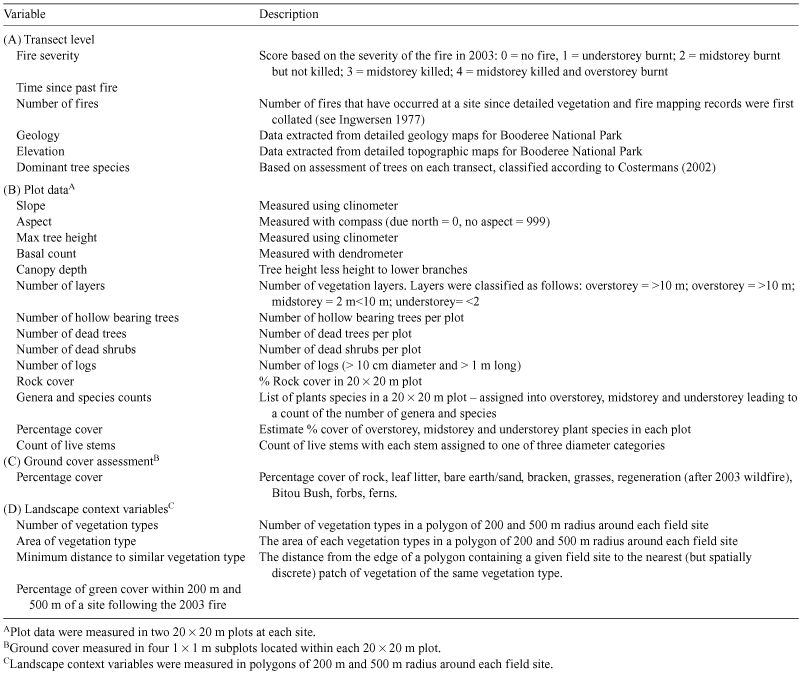Contrasting mammal responses to vegetation type and fire
D. B. Lindenmayer A D , C. MacGregor A , A. Welsh B , C. Donnelly A , M. Crane A , D. Michael A , R. Montague-Drake A , R. B. Cunningham A , D. Brown A , M. Fortescue C , N. Dexter C , M. Hudson C and A. M. Gill AA Fenner School of Environment and Society, W.K. Hancock Building [43], The Australian National University, Canberra, ACT 0200, Australia.
B Centre for Mathematics and Analysis, The Australian National University, Canberra, ACT 0200, Australia.
C Department of the Environment, Water, Heritage and the Arts, Jervis Bay Village, Jervis Bay Territory 2540, Australia.
D Corresponding author. Email: david.lindenmayer@anu.edu.au
Wildlife Research 35(5) 395-408 https://doi.org/10.1071/WR07156
Submitted: 28 September 2007 Accepted: 11 April 2008 Published: 19 August 2008
Abstract
The response of terrestrial mammals and arboreal marsupials to past burning history as well as a year prior to, and then for 4 years after, a major wildfire in 2003 at Booderee National Park, Jervis Bay Territory was quantified. The present study encompassed extensive repeated surveys at a set of 109 replicated sites stratified by vegetation type and fire history. It was found that most species exhibited significant differences in presence and abundance between major vegetation types. Detections of long-nosed bandicoot (Perameles nasuta) increased significantly in all vegetation types surveyed, in both burnt and unburnt areas. Temporal patterns in captures of three species of small mammals (bush rat (Rattus fuscipes), swamp rat (Rattus lutreolus) and brown antechinus (Antechinus stuartii)) showed a trend for lower numbers of captures on burnt sites compared with unburnt sites. Three species of arboreal marsupials, common ringtail possum (Pseudocheirus peregrinus), greater glider (Petauroides volans) and common brushtail possum (Trichosurus vulpecula), were moderately common and all showed marked differences in abundance between vegetation types. Whereas P. peregrinus and P. volans exhibited a temporal decline between 2003 and 2006, T. vulpecula exhibited a general increase from 2003 levels. However, arboreal marsupial responses did not appear to be directly fire related.
Additional keywords: arboreal marsupials, fire, medium-sized mammals, small terrestrial mammals, south-eastern Australia, vegetation.
Acknowledgements
This project is part of a major study in Booderee National Park. It is funded by the Australian Research Council, the Department of Environment and Water Resources and the Department of Defence. The strong support of the Wreck Bay Aboriginal Community is also most gratefully acknowledged and we are privileged to work on land that is co-managed by them. Scott Surridge, Peter Cochrane and Con Boekel have been important supporters of this project since its inception. Counts of terrestrial mammals were completed through the generous assistance of Earthwatch Institute volunteers and grants from that organisation. Additional assistance with field work was provided by Monica Ruibal, Nicki Munro and Rachel Muntz. Comments by two anonymous referees greatly improved earlier versions of this paper.
Andersen, A. N. , Cook, G. D. , Corbett, L. K. , Douglas, M. M. , Eager, R. W. , Russell-Smith, J. , Setterfield, S. A. , Williams, R. J. , and Woinarski, J. C. Z. (2005). Fire frequency and biodiversity conservation in Australian tropical savannas: implications from the Kapalga fire experiment. Austral Ecology 30, 155–167.
| Crossref | GoogleScholarGoogle Scholar |
Burbidge, A. A. , and McKenzie, N. L. (1989). Patterns in modern decline of Western Australia’s vertebrate fauna: causes and conservation implications. Biological Conservation 50, 143–198.
| Crossref | GoogleScholarGoogle Scholar |
Chambers, L. K. , and Dickman, C. R. (2002). Habitat selection of the long-nosed bandicoot Parameles nasuta (Mammalia: Peramelidae), in a patchy urban environment. Austral Ecology 27, 334–342.
| Crossref | GoogleScholarGoogle Scholar |
Coops, N. C. , and Catling, P. C. (2002). Prediction of the spatial distribution and relative abundance of ground-dwelling mammals using remote sensing imagery and simulation models. Landscape Ecology 17, 173–188.
| Crossref | GoogleScholarGoogle Scholar |
Debus, S. J. S. (1997). A survey of the raptors of Jervis Bay National Park. Australian Birds 30, 29–44.
Kavanagh, R. P. (1988). The impact of predation by the powerful owl Ninox strenua on a population of the greater glider Petauroides volans. Australian Journal of Ecology 13, 445–450.
| Crossref | GoogleScholarGoogle Scholar |
Kavanagh, R. P. , and Lambert, M. J. (1990). Food selection by the Greater Glider, Petauroides volans: is foliar nitrogen a determinant of habitat quality? Australian Wildlife Research 17, 285–299.
| Crossref | GoogleScholarGoogle Scholar |
Kearney, N. , Handasyde, K. , Ward, S. , and Kearney, M. (2007). Fine-scale microhabitat selection for dense vegetation in a heathland rodent, Rattus lutreolus: insights from intraspecific and temporal patterns. Austral Ecology 32, 315–325.
| Crossref | GoogleScholarGoogle Scholar |
Monamy, V. , and Fox, B. J. (2000). Small mammal succession is determined by vegetation density rather than time elapsed since disturbance. Austral Ecology 25, 580–587.
| Crossref | GoogleScholarGoogle Scholar |
Newsome, A. E. , McIIroy, J. C. , and Catling, P. C. (1975). The effects of extensive wildfire on populations of twenty ground vertebrates in south-east Australia. Proceedings of the Ecological Society of Australia 9, 107–123.
Tilley, S. (1982). The diet of the powerful owl, Ninox strenua, in Victoria. Australian Wildlife Research 9, 157–175.
| Crossref | GoogleScholarGoogle Scholar |
Wayne, A. F. , Cowling, A. , Ward, C. , Vellios, C. V. , Lindenmayer, D. B. , Donnelly, C. F. , and Rooney, J. F. (2006). The abundance of a threatened arboreal marsupial in relation to anthropogenic disturbances at local and landscape scales in Mediterranean-type forests in south-western Australia. Biological Conservation 127, 463–486.
| Crossref | GoogleScholarGoogle Scholar |

|


